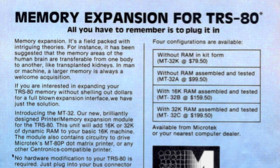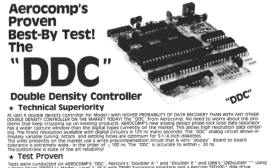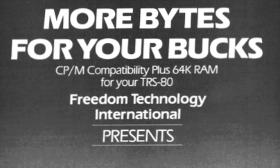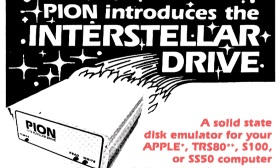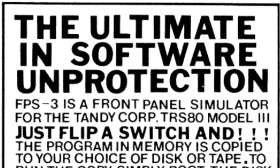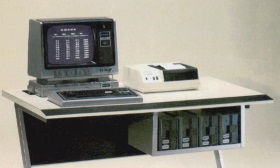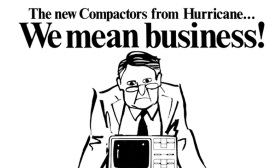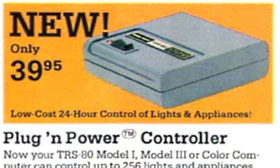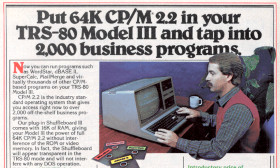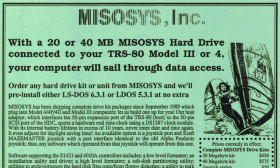Articles in the "Hardware" Category
By itself, the TRS-80 Model I was capable of only limited expansion. In order to add memory beyond 16K and support floppy disk drives, Radio Shack sold an external device they called an Expansion Interface.
The Expansion Interface could expand memory to 48K, add a parallel printer port, and add a disk controller for connecting floppy disk drives. But an Expansion Interface with 32K of memory cost $597.00, almost $100 more than a 4K Model I. What if a Model I owner didn’t want (or couldn’t afford) disk drives but still wanted to add memory and a printer port?
The MT-32 from Microtek, Inc. of San Diego, California used a different approach from the Radio Shack Expansion Interface. The MT-32, introduced in mid-1980, offered only two features: the ability to add 32K of RAM (for a total of 48K) and a parallel printer port.
(Read more...)
The Aerocomp DDC was a popular double-density add-on for the TRS-80 Model I. It was introduced in 1981 by Aerocomp Inc. of Dallas, Texas, a company founded by John Lancione. Aerocomp was one of the longest lasting TRS-80 companies and the Aerocomp DDC was sold for almost a decade.
When it was introduced, the Aerocomp DDC cost $149.95. This was $20 cheaper than its primary competitor, the Percom Doubler II. Aerocomp also sold the Aerocomp DDC bundled with a choice of operating systems: DOSPLUS 3.3 for $189.95 and with LDOS for $239.95.
The Percom Doubler was the original Model I doubler and the Aerocomp DDC was designed to be software compatible with it. The Aerocomp DDC (like the Percom Doubler) used double-density encoding to increase disk capacity on a 40-track single-sided disk from 100K to 180K
(Read more...)
The Freedom Option was a CP/M add-on for the TRS-80 Model I, Model III, and compatibles. It was introduced in early 1980 by Field Engineering Consultants (better known as FEC) of Woburn, Massachusetts.
Originally, FEC sold two Freedom boards, both for a 48K Model I with disk drives:
- The Freedom Option allowed CP/M (or the included T8/OS) to run by disabling the Model I ROM. It cost $245.00.
- The Memory Expansion Option had the same features as the Freedom Option, but also added an extra 16K of RAM. This provided a full 64K of RAM for the Model I, meaning that 57K was available for programs when running T8/OS. It cost $295.00.
Both the Freedom Option and the Memory Expansion Options were fairly small boards that installed inside the Model I case. As one advertisement stated they were “easy to install plug-in boards; no wires or traces to cut; no soldering.”
(Read more...)
The Interstellar Drive, also known as Pion’s Interstellar Drive, was a solid state disk drive emulator that was sold by Pion, Inc. of Arlington (later Watertown), Massachusetts. It was introduced in 1982 for a base price of $1,095.00 for the 256K version.
The Interstellar Drive was an external 9" by 8 1/2" by 4" unit with its own power supply. It was compatible with the TRS-80 Model III and Model 4 and included drivers for the TRSDOS and LDOS disk operating systems. By using different host interfaces, the Interstellar Drive was compatible with a number of computers, including the Apple II and the IBM PC.
Much like a modern solid state drive, the Interstellar Drive had no moving parts. It provided non-volatile data storage at speeds far greater than a hard drive (then commonly known as a Winchester drive) or a floppy drive. Advertisements described the Interstellar Drive as providing “five to fifty times faster performance than floppy disks and Winchester drives.”
(Read more...)
The FPS-3 was an unusual hardware add-on for the TRS-80 Model III and Model 4 that gave users the ability to make backup copies of their copy protected TRS-80 programs. It was created by Steve Sawyer and sold for $50.00 through his company J.E.S. Graphics of Tulsa, Oklahoma.
Most products that could defeat TRS-80 copy protection, such as Super Utility or Trackcess, were software that used the TRS-80 hardware to make exact copies of protected disks or tapes. This didn’t always work depending on the type of protection used. The most notable example was Super Utility, which couldn’t be used to make copies of itself!
Rather than use this approach, the FPS-3 was hardware that made copies of the data that a protected program loaded from disk or tape. It could create an exact snapshot of a program immediately after it had loaded into memory. As long as the protected program loaded completely from disk or tape with no overlays (as most did), the FPS-3 could be used to create an unprotected copy.
(Read more...)
The TRS-80 Micro Computer System Desk (catalog number 26-1301), also known as the TRS-80 System Desk, was Radio Shack’s recommended desk for the TRS-80 Model I. It was introduced in 1978 for a price of $199.00.
The TRS-80 System Desk was designed to hold a Model I, monitor, Radio Shack Expansion Interface, up to four floppy drives, and a TRS-80 Quick Printer, with all wiring hidden inside the desk. As one advertisement stated, the TRS-80 System Desk “concentrates your expanded TRS-80 system into one convenient area.”
(Read more...)
The Hurricane Labs Compactor was part of a series of products that modified the TRS-80 Model III to allow it to run CP/M programs. Hurricane Laboratories, better known as Hurricane Labs, was founded by Ronald L. Jones, a member of the Homebrew Computer Club who had a great deal of experience with CP/M.
There were three Compactor products for the TRS-80 from Hurricane Labs, all designed by Ron Jones:
- The Compactor I, introduced in late 1981, sold for $450.00, including a customized version of CP/M. It converted the Model III into a 48K CP/M computer.
- The Compactor II was introduced in late 1982. It added the same features as the Compactor I, but also doubled the Model III speed using a 4 MHz Z80A processor. The Compactor II included an extra 64K of memory to create a 112K CP/M computer. It also provided a real-time clock with battery backup. I have never seen a reliable price for the Compactor II.
- The Compactor IV wasn’t a CP/M board, but an 80 by 24 video board. It cost $475.00 and installed in place of the Model III RS-232 board. The Compactor IV emulated a Lear Siegler ADM-3A terminal, with reverse video, underline, and blinking. It also included a serial port to replace the one normally provided by the stock RS-232 board.
(Read more...)
Plug ‘n Power was Radio Shack’s brand name for products that used the X10 power line communications protocol. X10 was developed in 1975 by Pico Electronics, Ltd. of Glenrothes, Scotland. Radio Shack, along with Sears, Roebuck & Co. (with the Sears Home Control System) and BSR (with the BSR System X-10), was among the first sellers of X10 compatible products.
Radio Shack introduced their first Plug ‘n Power products in late 1979. Most of the products were appliance and light modules. These plugged into an electrical outlet, and an appliance or light was then plugged into the module. Some of those modules included:
- Appliance Module (catalog number 61-2681) cost $16.99 (originally $15.99)
- Lamp Dimmer Module (catalog number 61-2682) cost $16.99 (originally $15.99)
- Universal Appliance Module (catalog number 61-2684) cost $17.99
- Wall Switch Module (catalog number 61-2683) cost $17.99
- Wall Outlet Module (catalog number 61-2685) cost $21.95
The modules were designed to respond to commands sent over the electrical wires inside the house. They could turn on or off, or in the case of a lamp, change brightness. The advantage of using a power-line communication system was that it didn’t require any additional (and costly) signal wiring.
(Read more...)
The Shuffleboard and Shuffleboard III were CP/M hardware add-ons for the TRS-80 Model I and Model III. Although somewhat different products, each allowed unmodified CP/M programs to run on the TRS-80 by “shuffling” the TRS-80 memory map into one acceptable to CP/M.
Both the Shuffleboard and Shuffleboard III were created by Parasitic Engineering, but the Shuffleboard III achieved most of its popularity after Memory Merchant took over the product.
The original Shuffleboard was actually a companion to another Parasitic Engineering product, an 8" drive interface called the Maxi-Disk. Howard Fullmer and Gene Nardi created the Shuffleboard and Maxi-Disk and introduced them in May 1979 at the Fourth West Coast Computer Faire in Los Angeles, California.
The $995.00 (later $1079.00) Maxi-Disk consisted of two parts:
(Read more...)
The MISOSYS Hard Drive Kit was a hard drive interface for the TRS-80 Model III, Model 4, and Lobo MAX-80. (There was no version for the TRS-80 Model I.) It was announced in the Spring/Summer 1989 issue of The MISOSYS Quarterly and began shipping in September 1989. It came in in two configurations: 20 MB and 40 MB.
Although Roy Soltoff described the MISOSYS Hard Drive Kit as a “pre-assembled kit,” it came fully assembled, tested, and ready to connect to the TRS-80. The only other item needed was the “host interface cable” which cost $20.00 extra originally but was later included in the package.
The complete unit was housed in a 5.5" high, 7" wide, and 15" deep case, which had room for two half-height drives. The case contained a 60-watt power supply and fan. The shipping weight of the entire package was 20 pounds.
(Read more...)
